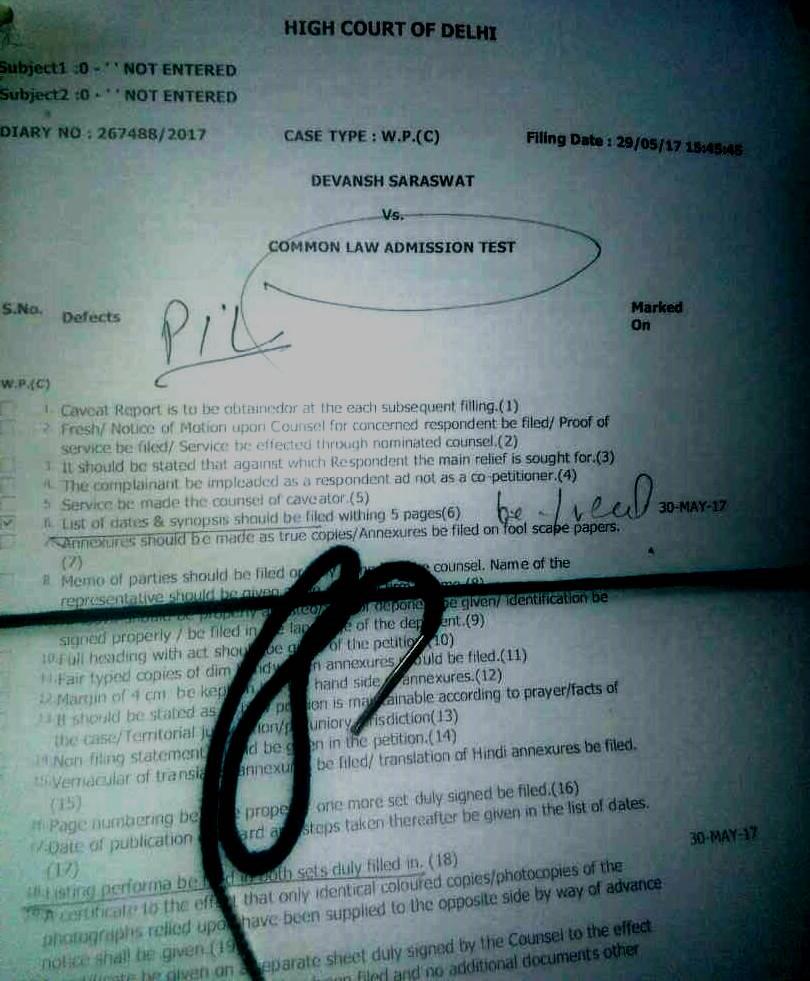
The first legal challenge to the Common Law Admission Test (CLAT) 2017 has been withdrawn as the petitioner, after repeatedly curing formatting and technical defects and filing his petition again in the Delhi high court, has decided to approach the court through a letter petition to the Chief Justice of the Delhi HC and the Chief Justice of India (CJI).
GNLU Gandhinagar second year student Devansh Saraswat, who had filed a writ for negligence, against CLAT 2017 convenor CNLU Patna on Monday, commented: “The [Public Interest Litigation (PIL)] has received various technical objections which any common man is devoid of knowing. This shows that it is nearly impossible to file a PIL in the court without an advocate, these courts only claim of being for the common man and accept letter as petitions. And this is what happened to me.”
“It is impossible to cure [the defects] without the assistance of a lawyer. I am preparing a letter petition instead and sending to HC chief justice and CJI of India. If anything can happen it will. If everyone sleeps it won’t,” he said.
A tale of re-filings
On 29 May Saraswat first attempted to file the PIL at 11am, but the size of the pages in his petition were “A4”, whereas the court accepts only “legal” page size. He then reprinted the petition on legal size pages and attempted filing at 3pm, but the registry had returned it because the index was missing from his petition. He then finally added the index and was able to file the petition by 4pm.
Saraswat had asked the court to stay the declaration of CLAT 2017 results and order the convenor to cancel the 14 May exam and conduct a fresh exam as 7.5% of the question paper was error-ridden and also there were technical glitches during the conduct of the online exam. However, since the result was due to be declared on the night of 29 May, in addition to a stay on results, Saraswat had asked for the alternate relief of stay on NLU admissions, until a re-exam was held.
He yesterday told us that his petition was returned again for defects. There are 33 defects in the latest version of Saraswat’s petition, as per the court, including objections that annexures should be signed, dated, stamped and made “true copy”, faults with indexing, mentioning of complete address, age and parental details of the petitioner, obtaining a caveat report at each subsequent filing, the petitioner personally presenting his plea to the respondent regardless of the locations of the two parties, certificate of having filed “complete tribunal record”, and such other technicalities.
Saraswat commented: “There are times when the Supreme Court has said that Procedural rules should not supersede substantive laws. The procedural rules are equally important as much as the rules of substantive law, but are not meant to defeat the substantive law or obstruct the administration of justice.”
“I have seen that courts can even take newspaper reports into consideration as a suo moto notice but the authorities sitting at the hierarchical suboordinate positions pick out technicalities as irrelevant to the matter as said above,” he noted.
threads most popular
thread most upvoted
comment newest
first oldest
first
threads most popular
thread most upvoted
comment newest
first oldest
first